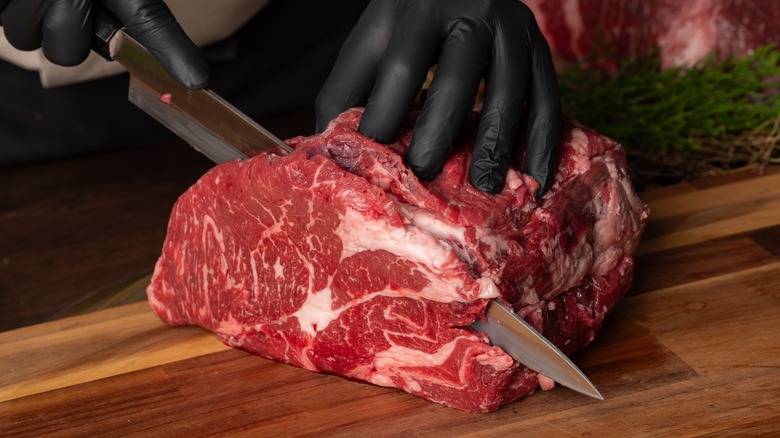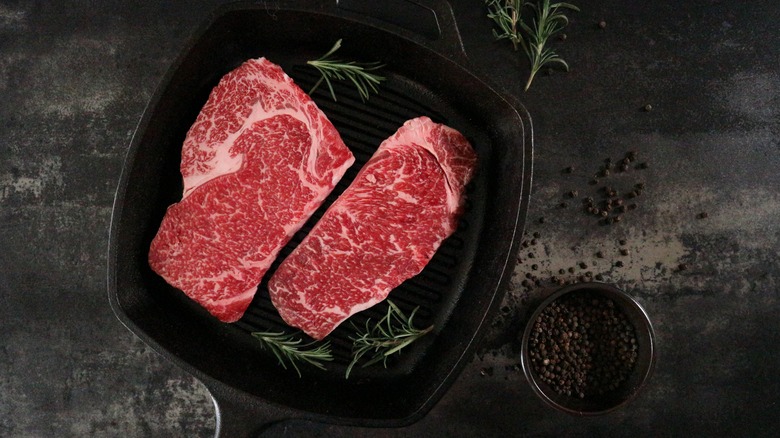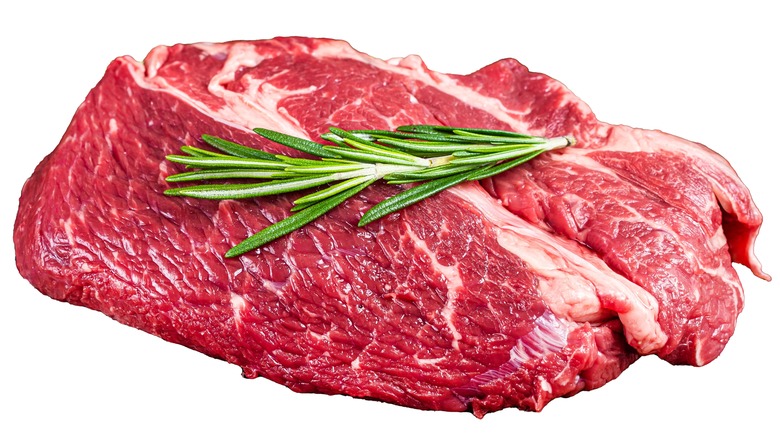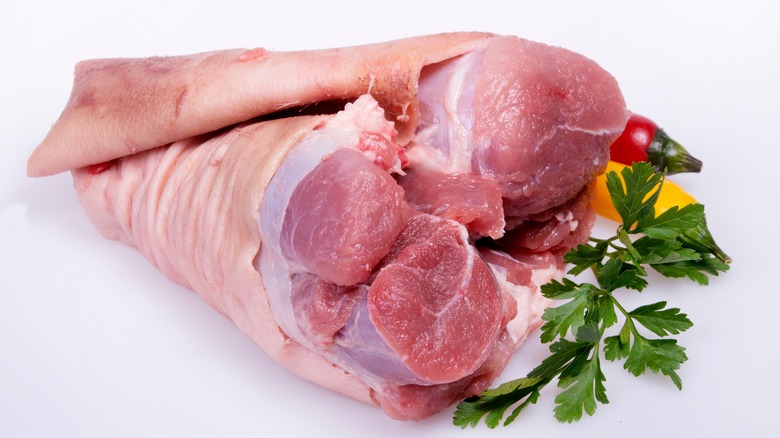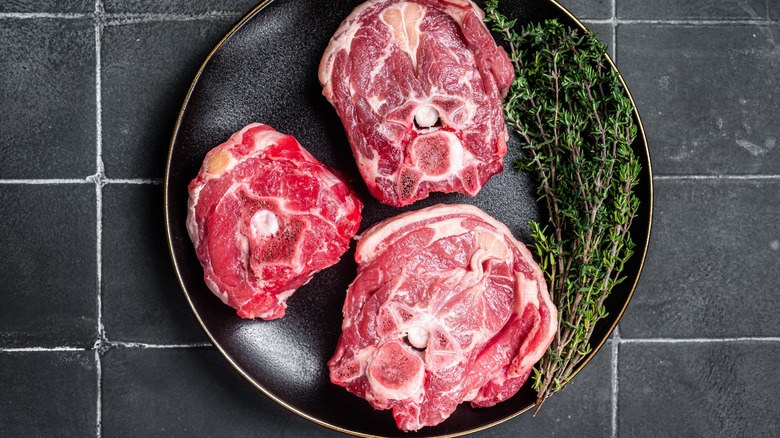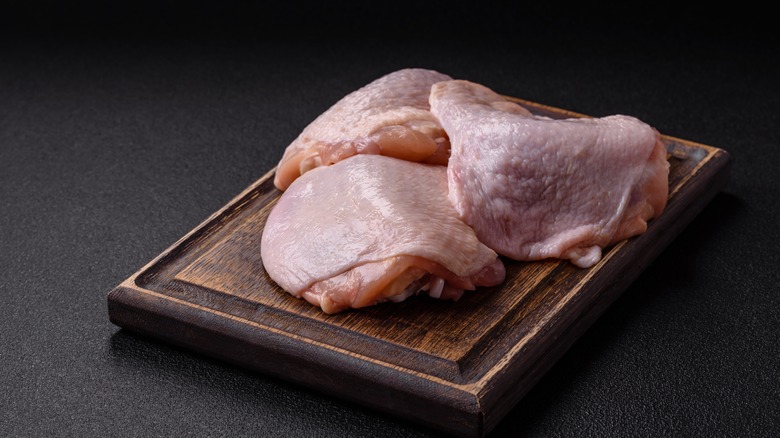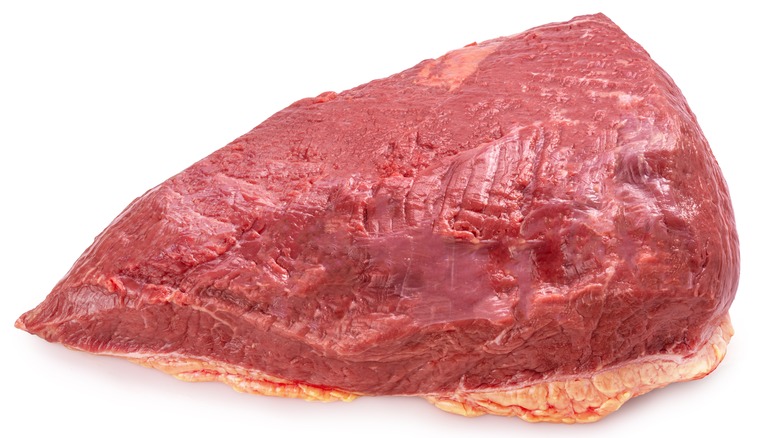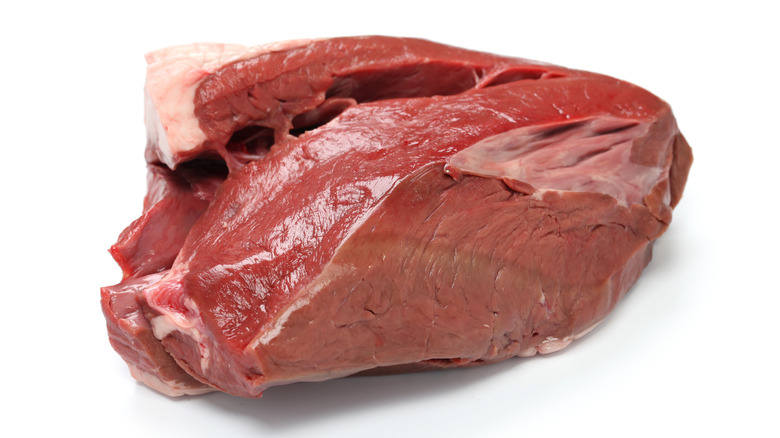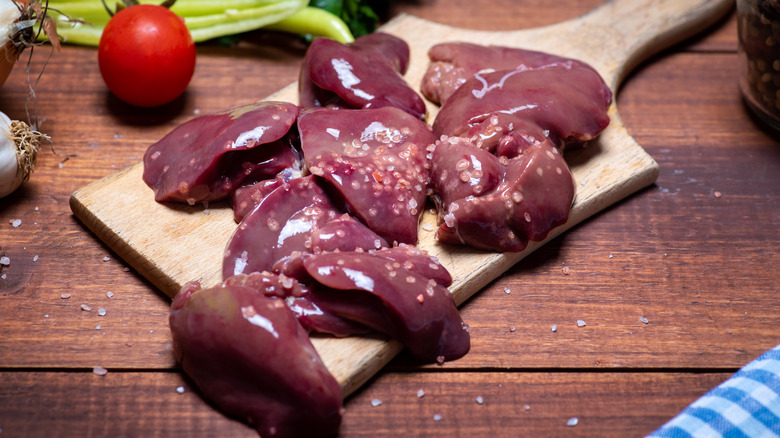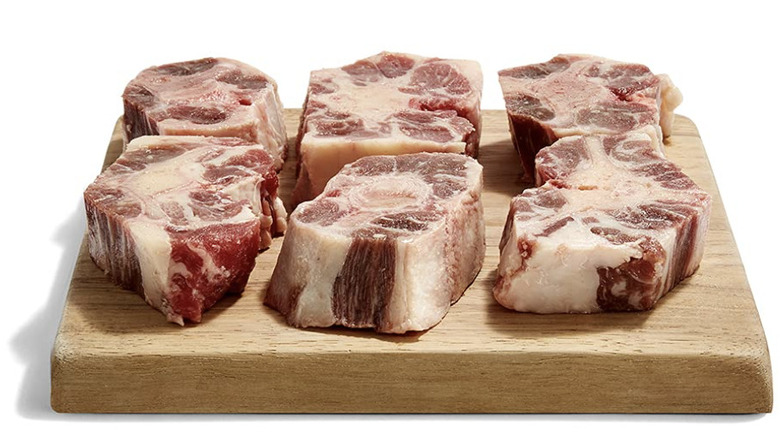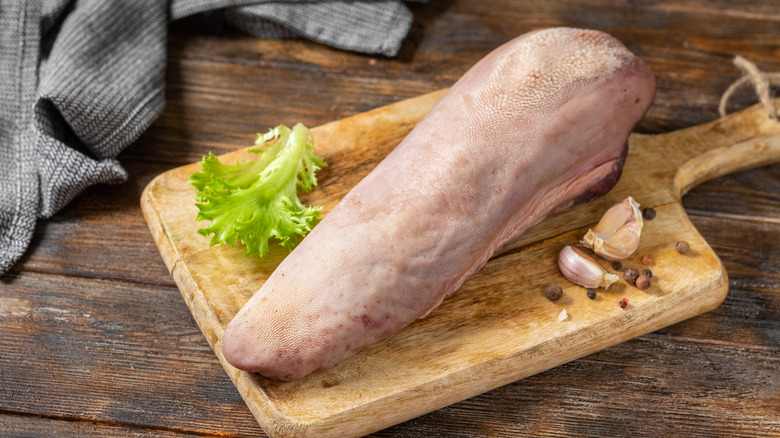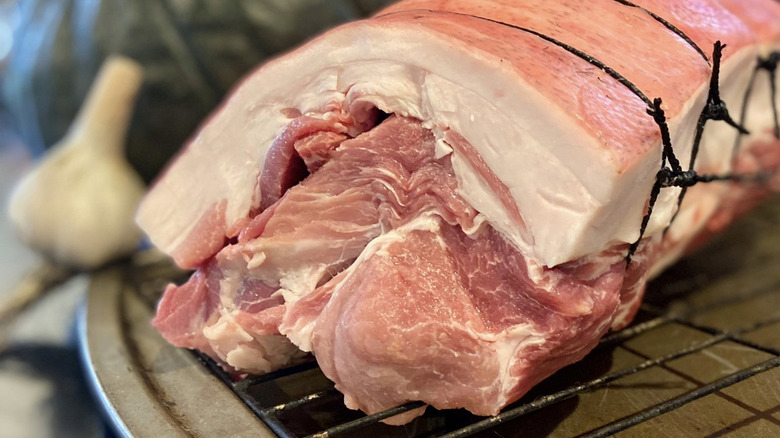11 Underrated Cuts That Chefs Love And You Will Too
We may receive a commission on purchases made from links.
Restaurant and home menus can be pretty predictable, showcasing popular cuts of meat like filet mignon, pork chops, and chicken breasts. While these options have definitely earned their rightful place in the kitchen, they can also leave little room for the culinary exploration of some less common butcher's cuts.
Nose-to-tail cooking has plenty of benefits. Using every part of an animal doesn't just reduce waste; it also encourages chefs to experiment with new flavor and texture combinations as well as different techniques such as slow cooking and braising. Less popular cuts of meat also tend to be more affordable than their more popular counterparts. For instance, while a pound of filet mignon is roughly $30, the same amount of sirloin will only set you back around $16, oxtail $7, and beef heart $4.
With so many exceptional cuts of meat on the market, we decided to shed light on the most undervalued options. To do this, we asked a number of leading chefs and experts to tell us about their favorite underrated cuts of meat and how to best prepare them.
Beef sirloin
The sirloin is commonly considered inferior to more fatty cuts of beef, such as ribeye or filet mignon. Indeed, beef sirloin can turn out tough if not properly prepared, particularly if we are talking about bottom sirloin steak and sirloin tip steak, which aren't as tender as top sirloin. Despite these limitations, sirloin is one of the favorite underrated steaks of Food Network chef Britt Rescigno. "I love the deep beefy flavor, and honestly, if you cook it right, it's soooooo tender and 100% sexy!" she told Mashed in an interview.
According to Rescigno, the best part of cooking with sirloin is the cut's versatility. Home chefs wishing to keep things simple can sear sirloin on a skillet until tender, just as they would any other cut of beef. "You don't have to do much — keep it simple," Rescigno says. "Add some salt, pepper if you'd like, and sear it in a pan or on the grill to the temperature you prefer. It's simply delicious."
Those who enjoy a little more complexity in their protein-based meals can also easily take the sirloin to the next level, as highlighted by Rescigno. "Sirloin is perfect for kabobs, steak tips for a salad, but my absolute favorite is to sear the steaks and serve [them] with a semi homemade mole sauce, street corn salad, and some avocado purée. It's a real showstopper that's super easy and really highlights that beautiful deep beefy flavor," she says.
Beef chuck
Chuck eye steak has been referred to as the poor man's ribeye, while smoked chuck roast is sometimes called poor man's brisket. Sourced from the shoulder of the cow — a relatively muscly area that gets its fair share of exercise — chuck is usually more affordable than other cuts of beef. While flavorful, chuck tends to have a lot of intersecting muscles, which can make it tricky to prepare. That said, some parts of the chuck, like the top blade, are more tender than other cuts from the same area.
While chef Britt Rescigno sometimes turns chuck into ground beef, she also enjoys the cut's rich flavor in other dishes. "For the chuck, you wanna braise that baby. Get it succulent and delicious with all the spices you'd like because it can handle it!" she says, adding that the chuck has a robust flavor that's unlikely to be overshadowed by seasoning. More specifically, Rescigno likes to use braised chuck in birria tacos. "Add some Chihuahua cheese to the tortillas, add the braised chuck, garnish with chopped onion and cilantro, serve the broth on the side for dipping, and you are about to have a moment with you and your tacos," she says.
Pork shank
Obtained from the front forearm of the pig, pork shank isn't as popular as some other pork products like bacon or ribs. This cut tends to be tougher and chewier because it comes from a well-exercised part of the animal. However, if sourced from a reputable supplier and appropriately cooked, pork shanks can be transformed into flavorful and relatively tender treats. In an interview with Mashed, Jeff Shields, a chef-instructor of Culinary Arts at the Los Angeles campus of the Institute of Culinary Education, recommends buying pork shanks from local, sustainable sources whenever possible. "Developing a relationship with a good butcher can also ensure you get the best cuts and advice on cooking them," he adds.
Shields notes that pork shanks can make delicious, cost-effective meals that are rich in flavor and texture. He particularly recommends slow cooking the cut of meat in a braise. "The results can be rich, meaty, and fall-off-the-bone flavorful," he says. "This is due to the fat and connective tissue [in the meat] that benefits from low and slow cooking to help break it down. [Pork shanks] can also make for an impressive plate for a restaurant or dinner party at home when served bone-in and whole."
Lamb neck
Lamb can be divided into eight main cuts of meat. The most tender parts of the animal include lamb rack, lamb rib chops, and lamb loin chops. Medium-tender cuts are lamb shoulder chops, lamb shanks, and lamb legs. Meanwhile, lamb neck and lamb shoulder are considered to be the least tender and least popular. However, despite the relative toughness of lamb neck, it is also very flavorful, making it a desirable addition to many dishes. All that's required is a little patience, since this cut can take some time to prepare.
Lamb neck is full of connective tissue, which can be both a blessing and a curse, since this imparts the cut with flavor but also makes it more difficult to prepare. Nevertheless, chef Jeff Shields can attest to the cut's potential, saying that when cooked and processed properly, even the toughest and most underrated cuts of meat can be delicious. "Due to the content of fat and connective tissues in the neck, slow roasting and braising are best suited for preparing lamb neck. The results can be tender, succulent and packed with delicious lamb flavor," Shields says. "Lamb neck can be used in stews and braises. One of my favorite things to do with lamb neck is braise it and make a ragu to serve with pasta like pappardelle."
Chicken thighs
While not as unconventional as chicken necks or feet, chicken thighs tend to be less popular in cooking than chicken breasts, drumsticks, or wings. According to chef Jeff Shields, this is a shame. "Thighs are far more flavorful and juicier than the breast. They are much more versatile and cheaper than the breast as well," he says.
Cut from the upper part of the chicken legs, chicken thighs are darker in color than the breasts and drumsticks. While they tend to have more tendons than the more popular chicken cuts, thighs also have a high fat content. This is precisely what makes them so flavorful. It's also why Shields likes to use them in his dishes. "Where a chicken breast can easily dry out when cooked, the fattier thigh remains nice and juicy," he says, adding that he likes to prepare them braised, grilled, fried, or roasted.
Easily found at most supermarkets, chicken thighs can be purchased with the bone in or out and with or without the skin. The boneless and skinless cuts usually carry a slightly higher price tag. Regardless of the cut, chicken thighs can be turned into a wide range of delicious dishes, from simple meals such as oven-baked chicken thighs and one-pot chicken and rice to more complex offerings like crispy baked deviled chicken thighs.
Picanha
Popular in Brazil and Portugal, the picanha has gained some traction in the U.S., although it's far from being as popular as some other cuts of beef. Also known as rump cover, rump cap, and sirloin cap, the picanha comes from the rump area of the cow. Tender and flavorful, the picanha is a staple in many of the best Brazilian steakhouses across the nation, such as Fogo de Chão and Texas de Brazil, where it's carved tableside straight from large skewers. Unfortunately, picanha isn't commonly found in supermarkets. So if you're in the mood for this particular cut, you might need to hit up a higher end butcher shop.
Alec Bradford, the owner of Herd Provisions, a farm-to-table restaurant and whole-animal butcher shop in Charleston, South Carolina, tells Mashed that the picanha is one of his favorite cuts of beef. And when it comes to cooking the protein, Bradford advises pan searing it with a little butter, garlic, and herbs. "Take [the picanha] out of the refrigerator for at least an hour before cooking to shorten cooking time but also allow for more even cooking. Score and sear fat side down on a slightly lower heat to render some of the fat. Look for a thick fat cap. [It's] best served medium-medium rare," he says.
Beef heart
In the U.S., organ meats like the heart, liver, and kidneys are often seen as less desirable than cuts such as steaks, pork chops, or chicken breasts. Nevertheless, offal like beef heart can make a surprisingly delicious — and affordable — addition to your kitchen repertoire. Weighing three to four pounds, beef hearts are packed with nutrients and vitamins, including iron, folate, selenium, zinc, and vitamin B12. While beef hearts can be purchased whole, with fat, valves, tendons, and an outer membrane, you can ask your butcher to remove these and cut the heart into more manageable pieces.
Beef heart has a beefy, slightly gamey flavor, but is a little milder than some other offal like liver or kidneys. Chef Matt Bolus from The 404 Kitchen in Nashville, Tennessee, says in an interview with Mashed that beef heart is his go-to choice for underutilized cuts of meat. "It has absolutely amazing flavor and texture and always surprises people that it doesn't taste like organ meat," he says. Bolus also emphasizes that beef heart is one of the most versatile muscles when it comes to cooking. "I have used it to make tartare, I have used it in stews, I have ground it for burger meat, and I have marinated it, flash grilled it, and served it like a steak cooked medium rare," he says.
Chicken livers
Chicken livers are a nutritional powerhouse. These little morsels are loaded with protein, vitamins A and B12, and minerals like iron, phosphorus, selenium, and copper. As such, it's a shame that they aren't more popular in home and restaurant kitchens. It's likely that the culinary potential and health benefits of chicken livers have been overlooked due to the stigma sometimes associated with eating organ meat. Some people also find the slightly metallic and bitter flavor of chicken livers less desirable than that of other cuts of meat or offal.
Incorporating chicken livers into recipes gives chefs a great opportunity to experiment with new flavors and cooking techniques. Ideal for a quick meal on the run, baked chicken livers are both easy and fast to prepare. Besides the star of the show, all the recipe requires is a simple set of ingredients that can be found in most pantries, including garlic powder, onion powder, extra virgin olive oil, oregano, and dried thyme. Just combine all of the ingredients together, and pop them in the oven. Chicken liver kebabs are another simple and flavorful recipe that might just change a few minds about this underutilized offal. All you need to get this recipe off the ground is a backyard barbecue, a few skewers, a dollop of butter, lemon juice, and a little parsley.
Oxtail
Despite its name, oxtail can be cut from the tail of any cattle, either male or female. Weighing around seven or eight pounds, the tail is composed of bone, meat, and fat and is usually cut into 2-inch oval portions for easy preparation. One of the reasons why oxtail may not be as popular as some other beef cuts is that it requires a long cooking time to become tender. Despite this, oxtail has recently seen a revival in the U.S., with more chefs incorporating it into recipes. As a result, it's driving the prices of the once cheap protein to new heights.
Chef Matt Bolus from The 404 Kitchen believes that oxtail is a hidden gem among lesser-known cuts of meat. "Oxtail will hands down make the best stew you've ever imagined," he says, adding that braising and pressure cooking are the best techniques for unlocking oxtail's complex flavors. It's this slow cooking process that breaks down the connective tissue, bone marrow, and cartilage in the cut, creating a tasty, fall-off-the-bone meat. Oxtail can also be easily incorporated into soups, such as pot-au-feu-style oxtail soup and even used in more unexpected culinary creations like oxtail tacos.
Beef tongue
There's no escaping it — beef tongue is a strange-looking cut of meat. Long and tapered, with a rough and bumpy texture, the organ can be a little visually challenging for the uninitiated. However, for those ready to overlook its unconventional appearance and put in a little work, the tongue can be a culinary gem.
Beef tongue is composed of the tongue muscle, fat, and connective tissue, and it can be cut up depending on the desired recipe. The cut also comes with a tough outer layer of skin that needs to be removed before or after cooking. Provided that it's slow cooked, beef tongue can make a flavorful and tender addition to a wide range of dishes, from Mexican-style tacos to beef tongue stir-fries.
Beef tongue is a personal favorite of chef Matt Bolus, who highlights that the protein is more versatile than some people give it credit for. "It can be a tough cut if not cooked properly, but when it is, this cut is tender, juicy, and has such a rich flavor," he says. "I like to slice it thin, marinate it overnight, flash sear it in a pan with the marinade, and put it over a fresh spring salad. I also like to braise it or pressure cook it, peel it, press it in a terrine mold (with enough tongues to fill the mold), then slice it thin, and make a sandwich with it using Dijon mustard and Leicester cheese."
Pork coppa
Less popular than pork loin or pork belly, pork coppa is cut from the shoulder of the pig, just above the butt. This low profile is surprising since the cut can be both very tender and flavorful, and it is a favorite among competition barbecue pitmasters. Sometimes also called the pork collar or the money muscle, the coppa contains a lot of intramuscular fat, tissue, and collagen, which make it melt-in-the-mouth tender if cooked properly. Pork coppa is popular in Italy, where it's called capocollo and often appears on charcuterie boards in a cured form. While pork coppa might not be as readily available in the U.S. as it is in Italy, the cut is often considered the most underrated cut of pork and is definitely worth seeking out.
Pork coppa is typically roasted, a process that makes it both tender and juicy. To prepare it for roasting, pork coppa is commonly seasoned with a little salt and pepper as well as a mixture of herbs and spices. The cut can also be marinated for additional flavor and tenderness. Pork coppa is normally slow roasted at a lower temperature to allow the meat to cook evenly and maintain its moisture. Coppa can also be braised on the stovetop, cooked sous vide, or cut into thin slices and seared in a skillet.
